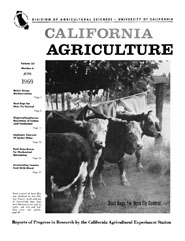


University of California
California Agriculture
|
|||
|
|||

Dust bags for horn fly control.
Cover:
Good control of horn flies was obtained at this Plumas County ranch with use of insecticidal dust bags seen hanging across gate to water, salt lick and bedding area.
June 1969
Volume 23, Number 6 |
|||
|
University of California, 1301 S. 46th St., Bldg. 478 Richmond, CA
|